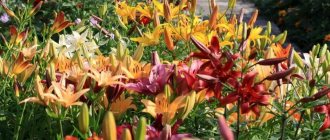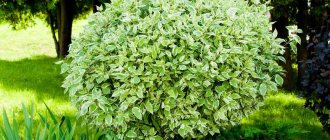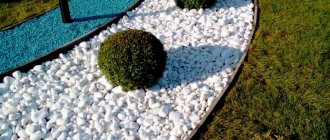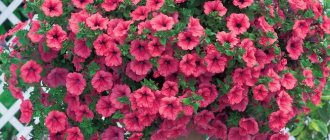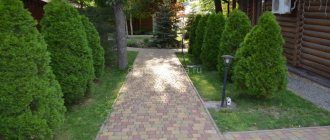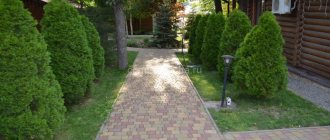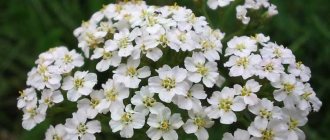True jasmine shrub is an evergreen heat-loving plant. In temperate latitudes it is used for growing indoors and is rightfully considered a decoration for the winter garden.
Indoor jasmine is an evergreen flower with an amazing aroma
At dachas in the Moscow region, the Urals, and Siberia, mock orange is grown, which is also often sold under the name “jasmine.” This is the name given to the deciduous shrub for the similarity of its aroma to a southern flower.
“Garden jasmine” tolerates our cold winters well and is found in many front gardens in Central Russia
History of the use of jasmine in gardens
Jasmine bush
There are several versions of the homeland of the garden jasmine plant. The plant is considered the national flower of many countries. Yasmin, which means fragrant flower, is prized as a culinary spice in Pakistan. In the states of India and the Philippines they are used to create flower garlands for newlyweds. According to another version, the flower comes from the Mediterranean; mythical nymphs used it to decorate their wreaths.
Shrub jasmine is a fairly tall plant with long shoots
There are references to the cultivation of the crop in the gardens of Chinese emperors. In Latin American countries, jasmine has long been an attribute of religious rituals.
The fragrance of jasmine intensifies in the evening and at night. This feature has given rise to many legends and myths.
Reasons for the popularity of this shrub
Garden jasmine is valued in many countries around the world for its high content of essential components; the flowers are grown for the perfume and cosmetic industries, and the oil of the petals is used for medicinal purposes, as a flavoring agent for tea, coffee, and confectionery.
Jasmine oil has an antiseptic, wound-healing and soothing effect
Jasmine vine is extremely beautiful, continues to bloom for up to 3 months, exuding a delicate sweetish aroma.
Potted forms of plants are used in landscape design. In the summer, the bushes are taken out into the garden, where magnificent plants create an extraordinary atmosphere of comfort and harmony.
Real jasmine in cold regions is grown exclusively as a houseplant or greenhouse plant.
Collection / preparation / preparation / composition
The king of flowers or the queen of the night is what people call the jasmine bush. It's not just about beauty, but also about the features of the collection. Jasmine flowers bloom late, in the dark, and are recommended to be collected before sunrise. This is the most favorable period when the concentration of essential oils is highest.
Which jasmine flowers are worth collecting:
- volumetric,
- healthy looking
- those that have not yet fully blossomed,
- not spoiled by insects.
Pick flowers carefully, trying not to damage or crush them. Even when putting collected jasmine into containers (fabric bags, baskets, clay vases, wooden boxes), do not press or press them, saving space. It is forbidden.
Before drying, sort and wash the petals. Lay out the clean buds and pre-dry them on paper. Let the moisture drain. The drying period is 10-15 days, or dry the jasmine in the oven.
It is recommended to collect flowers in the evening, in good weather, and immediately dry them in the oven.
Jasmine is an excellent honey plant, because the aroma of the bush is so delightful that bees do not miss the period of its flowering.
Reproduction, planting and care
Jasmine flower is a type of shrub that does not require maintenance or care. Loves partial shade, buds quickly droop in direct sunlight. The plant develops well in a temperature range of +18...26°C, high and moderate humidity, and can safely tolerate nighttime drops down to +10°C.
The plant can be planted in early autumn or early spring before buds open.
For planting, choose slightly acidic, nutritious soil rich in humus. The bush is periodically watered with acidified water. Fertilizing is carried out during the period of budding and flowering. Apply complex fertilizers for indoor flowers "Agricola" or liquid fertilizers with biostimulants.
Fertilizing has a positive effect on the strength of jasmine flowering
In the spring, the vine is pruned, the shoots are shortened by 1/3 to stimulate branching and the formation of a large number of buds.
Dried and thickening branches are cut off first.
Varieties of the Sambac variety are pruned once every three years, the rest of the jasmines - annually.
Propagation is practiced by air layering or cuttings. It takes a long time to propagate jasmine seeds. For cuttings, select 4-year-old shoots, cut the branches into 15 cm fragments so that each has 3-4 leaves. To form roots, they are kept in a solution of a growth stimulator or embedded in a moistened nutrient substrate with moisture-reducing components, and periodically moistened. After a bunch of roots appears, the seedling is ready for planting.
When propagated by cuttings, jasmine retains its varietal characteristics
Air layers are separated using the dropwise method. For rapid growth, cuts or scratches are made on the bark.
When planting purchased seedlings, carefully inspect the roots and remove damaged and dried fragments of the roots. Before planting, the root part of the plant is dipped into the mash. Make a mixture of slurry, fluff and clay in equal parts, dilute it to the consistency of sour cream. Shoots are shortened by 2/3 for better survival.
The tree trunk circle needs to be mulched to protect the roots from freezing
Be attentive to your body's reactions if:
- Individual intolerance is present.
- An allergic reaction to flowering or eating jasmine in any form is triggered.
- After eating jasmine, there is an unpleasant sensation.
- Itching and redness of the skin after contact with a compress or jasmine oil.
- Open wounds, boils + large amounts (concentrated) of jasmine.
It is recommended to minimize jasmine in any form during pregnancy It contains caffeine, which should be taken into account in the early stages of pregnancy. Or reduce the daily intake to a minimum, one cup in the morning.
Jasmine is not limited to its medicinal properties. Its oil is used in cosmetology, perfumery and cooking.
Jasmine is used in cosmetology in the form of skin care products for the face, body and hands. Crushed jasmine leaves are used for corns and dry calluses.
Bath with jasmine - relaxes at the end of the working day. 2-3 drops of essential oil work wonders. It should be added to honey, and only then to a bath of water; high concentrations are dangerous for the skin. Keep an eye on this. If you like to soak in warm water for a long time, then we draw your attention to the fact that a jasmine bath should be taken for 15-20 minutes, no longer.
Comparison with mock orange and combination options
Mock orange and jasmine are unlikely to be found together. Cultures have too many differences. Evergreen jasmine grows in the southern regions, on loose soils, and loves shade and partial shade. Mock orange - cultivated in temperate latitudes, unpretentious to the composition of the soil, loves the sun.
The photo shows mock orange flowers, often called “garden jasmine”
Depending on the variety, the aroma of mock orange varies from jasmine to the unpleasantly bitter characteristic of hydrangeas. Another difference is the bark. The southern representative becomes woody when it ages, 5–6 years after planting. The mock orange immediately produces stems wrapped in brown bark. The wood of the unpretentious mock orange is hard and inactive.
The photo shows real jasmine flowers with elongated petals
The inflorescences of cultures also differ. Jasmine has straight flowers, mock orange has goblet-shaped flowers, and many varieties have semi-double and double flowers. Jasmine varieties cannot boast of such splendor.
How to brew jasmine tea:
An important rule that is often neglected is water temperature. This is the case when boiling water destroys all healing properties. Therefore, it is worth using boiled water, 80 degrees.
First, place 2 teaspoons of flowers, which should stand, so the aroma will be more intense. Pour a liter of water over the flowers and leave for 7-10 minutes.
If jasmine tea in its pure form does not suit you, you can add flowers to black or green tea leaves. The benefits of jasmine are reduced, but the aroma and taste only benefit from this. Proven.
You can add honey to taste.
Photos of beautifully decorated garden plots with jasmines
For hedges, varieties of mock orange are used - plants of the hydrangea family. Jasmine flower photo shrub of the olive family is used to decorate open terraces and recreation areas.
Garden jasmine is a very spectacular plant
Bushes are planted near artificial reservoirs, and unsightly buildings are camouflaged with plantings, creating partial shade for the bushes. Arches and fantasy compositions are formed from varieties of garden climbing jasmine when planted in containers. In winter, crops are decorated in winter gardens; in summer, containers are placed on a blind area under the windows. The wonderful aroma can repel blood-sucking insects.
Luxurious jasmine bush on the shore of an artificial pond
Wooden pergola entwined with branches of climbing jasmine
A cozy place to relax in the shade of blooming jasmine
In the southern regions, jasmines are grown on trellises along chain-link fences. Combine yellow-flowered and red-flowered varieties. The dark greenery of the medicinal variety serves as a good background for parterre lawns made of cereal grasses.
Climbing jasmine hedge with white flowers
Shrub jasmine hedge with yellow flowers
Top varieties for regions
The Moscow region and Siberia are regions with cold winters. Not every plant is able to survive in such conditions; Siberian frosts are especially severe. However, mock orange, unlike jasmine, is more resistant to low temperatures. Both foreign and Russian selections have varieties with increased resistance to frost.
We recommend reading about when and how to plant jasmine.
For the Moscow region
For wet winters, with frequently changing temperatures due to cyclones, varieties with woody shoots and a wide crown are suitable.
Popular varieties in the region:
- Manto de'Ermine (Ermine mantle) - semi-double, white, with a strawberry aroma;
- Snow avalanche - snow-white inflorescences with a berry aroma, lush flowering;
- Elbrus - white terry brushes of flowers with a diameter of 4.5 cm;
- Dame Blanche - semi-double, with a delicate aroma, snow-white;
- Dwarf - does not bloom, decorative, glossy foliage of dark green color. Used as borders.
Important! To increase plant endurance in the fall in 1.5 months. Before the first frost, phosphorus fertilizers are applied to the tree trunk circle for digging.
For Siberia
In Siberia, winter temperatures are much lower than in the Moscow region, but the frost is dry. The bushes need pre-winter cover of the tree trunk circle with a layer of mulch and spruce branches. When snow falls, it is raked over the covering material, using it as an additional thermal cushion.
Suitable varieties for growing:
- Alabaster - large, double, fragrant, snow-white flowers;
- Belle Etoile - the bud is pink at the base, and the petals are white, has a jasmine aroma;
- Airborne - simple cream-colored flowers with a berry scent;
- Aurea - beige petals, yellow foliage;
- Lavina is a weeping type of shrub, small white flowers with a strawberry scent;
- Snow storm - snow-white inflorescences cover the entire bush with a dense cloud;
- Pompom - terry baskets are collected into large dense balls;
- Pearl - shoots with a red tint to the bark contrast with white flowers and bright green foliage;
- Gnome - dwarf, small-leaved, non-flowering. Decorative glossy yellow foliage.
Both plants are beautiful in their bloom. In our latitudes, mock orange is preferable to tender heat-loving jasmine. This crop can be grown in a winter garden or selected as an indoor variety.
Photo of jasmine in the garden
Kinds
Jasmine beesianum / Jasminum beesianum
It grows along river banks and in the Western Chinese mountains at an altitude of up to 2.5 km above sea level. Shrubs, vines or evergreens growing up to 2 m in length. The shoots are longitudinal with grooves. The leaves are simple, arranged opposite, lanceolate or ovate, pointed, grow up to 5 cm in length, dark green, slightly pubescent on both sides. This jasmine blooms in May with fragrant, dark pink or pink flowers, growing in diameter up to 1.3-1.7 cm. Flowers grow at the top of the shoots one, two or three at a time.
Jasmine nudiflorum / Jasminum nudiflorum
This species is a shrub, weakly branched, drooping shoots, long and with a small number of leaves. The leaves are bright green, small and trifoliate. In winter, jasmine sheds some of its leaves. This species is called “winter jasmine” because It blooms from mid-winter to mid-spring. Large, egg-yolk-colored flowers grow along the entire stem from the leaf axils.
Grandiflora jasmine / Jasminum grandiflorum
These are vines, shrubs and evergreens with bare shoots that grow up to 10 m in length. The variegated leaves grow opposite each other. Up to seven elliptical-shaped leaves, pointed at the top, are formed on the leaf, the length of which reaches a maximum of 3 cm. At the tops of the shoots, up to 10 fragrant, white and large flowers are collected in an umbrella-like manner. Flowering period from June to October. Flowers of this species are added to tea for flavor.
Jasmine officinale / Jasminum officinale
On the long, smooth, thin and angular branches of this perennial shrub grow two or three paired leaves. The leaves are bright green on top and light green on the bottom of the leaf blade. The smooth leaves are pubescent along the edges and have an elongated lanceolate shape with a point at the top of the leaf. It blooms in April with very fragrant white flowers, arranged in umbrella-type inflorescences on long stalks.
- Vriesea - care, photos, types
Multifloral jasmine / Jasminum polyanthum
This weakly branching shrub with climbing shoots grows up to 2 m in height. The dark green leaves are oval in shape, pointed at the top and wavy at the edges. Numerous flowers grow on the tops of the shoots. Three to five narrow-tubular flowers with a bend of five blades are collected. Pink buds. The flowers of this species have the strongest aroma.
Low jasmine / Jasminum humile var. glabrum
It grows in mixed forests of the subtropical part of Western China at an altitude of 1-2.5 km above sea level. Evergreen plants or shrubs with bare shoots, growing up to 2 m in height. The leaves, dark green above and light green below, grow up to 2.5 cm in length, are trifoliate, and can have up to 7 elliptical or ovoid leaves. Fragrant flowers are collected in groups of several in umbrellas. The corolla of the flowers is yellow, up to 1 cm in diameter, as is the corolla tube. Flowering period is summer.
Jasmine turned away / Jasminum humile var. revolutum
The ovoid leaves grow in 5-7 pieces and reach up to 6 cm in length. They have multi-flowered inflorescences with flowers growing up to 2.5 cm in diameter and a tube up to 2.5 cm in length.
Jasmine sambac (Arabic jasmine) / Jasminum sambac
Or Arabian jasmine (Jasminum sambac) . The species is native to tropical Asia. These evergreen plants or vines with thin shoots and pubescent with fine hairs grow up to 6 m in length. The leaves are arranged oppositely in 2-3 pieces, are egg-shaped and up to 10 cm long. Usually round at the base, and either blunt or pointed at the top ; glabrous or slightly pubescent. White double or semi-double flowers are collected in umbrellas of several pieces and smell very pleasant. It blooms from the arrival of spring to mid-autumn. Flowers of this species are added to tea for aroma.
Subtle jasmine / Jasminum gracillimum
Or multi-flowered jasmine (Jasminum multiflorum). It grows in the mountainous part of the northern region of the island. Kalimantan. These shrubs, evergreens or vines have hairy, thin shoots. The leaves are simple, lanceolate-oval in shape, grow opposite and reach a length of 3.5 cm; pointed at the top, and heart-shaped at the base, pubescent below. The flowers are white, fragrant and large. The flowering period is from January to March.
Trimming Features
In order for the jasmine bush to be lush and fragrant, fertilizing alone is not enough; it also needs to be properly cared for.
In order for the crown to always look well-groomed and impressive, regular formative pruning should be carried out. Both summer residents and gardeners have several secrets and rules regarding this procedure:
- formative pruning must be carried out in spring, when the shrub is in a vegetative state;
- the longest branches need to be cut off completely, and short ones should be shortened by ½ part;
- for more abundant flowering, rejuvenating pruning is carried out, or rather, all empty branches are removed;
- in an adult bush, the central trunk needs to be cut to 45–50 centimeters, while the rest are removed entirely.
Every year it is necessary to inspect the bush and remove damaged and diseased branches.
